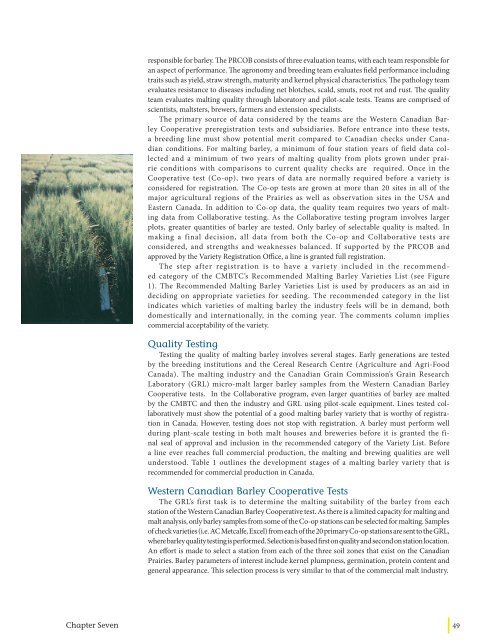MALTING QUALITY TRAITS - Canadian Malting Barley Technical ...
MALTING QUALITY TRAITS - Canadian Malting Barley Technical ...
MALTING QUALITY TRAITS - Canadian Malting Barley Technical ...
You also want an ePaper? Increase the reach of your titles
YUMPU automatically turns print PDFs into web optimized ePapers that Google loves.
Chapter Seven<br />
responsible for barley. The PRCOB consists of three evaluation teams, with each team responsible for<br />
an aspect of performance. The agronomy and breeding team evaluates field performance including<br />
traits such as yield, straw strength, maturity and kernel physical characteristics. The pathology team<br />
evaluates resistance to diseases including net blotches, scald, smuts, root rot and rust. The quality<br />
team evaluates malting quality through laboratory and pilot-scale tests. Teams are comprised of<br />
scientists, maltsters, brewers, farmers and extension specialists.<br />
The primary source of data considered by the teams are the Western <strong>Canadian</strong> <strong>Barley</strong><br />
Cooperative preregistration tests and subsidiaries. Before entrance into these tests,<br />
a breeding line must show potential merit compared to <strong>Canadian</strong> checks under <strong>Canadian</strong><br />
conditions. For malting barley, a minimum of four station years of field data collected<br />
and a minimum of two years of malting quality from plots grown under prairie<br />
conditions with comparisons to current quality checks are required. Once in the<br />
Cooperative test (Co-op), two years of data are normally required before a variety is<br />
considered for registration. The Co-op tests are grown at more than 20 sites in all of the<br />
major agricultural regions of the Prairies as well as observation sites in the USA and<br />
Eastern Canada. In addition to Co-op data, the quality team requires two years of malting<br />
data from Collaborative testing. As the Collaborative testing program involves larger<br />
plots, greater quantities of barley are tested. Only barley of selectable quality is malted. In<br />
making a final decision, all data from both the Co-op and Collaborative tests are<br />
considered, and strengths and weaknesses balanced. If supported by the PRCOB and<br />
approved by the Variety Registration Office, a line is granted full registration.<br />
The step after registration is to have a variety included in the recommended<br />
category of the CMBTC’s Recommended <strong>Malting</strong> <strong>Barley</strong> Varieties List (see Figure<br />
1). The Recommended <strong>Malting</strong> <strong>Barley</strong> Varieties List is used by producers as an aid in<br />
deciding on appropriate varieties for seeding. The recommended category in the list<br />
indicates which varieties of malting barley the industry feels will be in demand, both<br />
domestically and internationally, in the coming year. The comments column implies<br />
commercial acceptability of the variety.<br />
Quality Testing<br />
Testing the quality of malting barley involves several stages. Early generations are tested<br />
by the breeding institutions and the Cereal Research Centre (Agriculture and Agri-Food<br />
Canada). The malting industry and the <strong>Canadian</strong> Grain Commission’s Grain Research<br />
Laboratory (GRL) micro-malt larger barley samples from the Western <strong>Canadian</strong> <strong>Barley</strong><br />
Cooperative tests. In the Collaborative program, even larger quantities of barley are malted<br />
by the CMBTC and then the industry and GRL using pilot-scale equipment. Lines tested collaboratively<br />
must show the potential of a good malting barley variety that is worthy of registration<br />
in Canada. However, testing does not stop with registration. A barley must perform well<br />
during plant-scale testing in both malt houses and breweries before it is granted the final<br />
seal of approval and inclusion in the recommended category of the Variety List. Before<br />
a line ever reaches full commercial production, the malting and brewing qualities are well<br />
understood. Table 1 outlines the development stages of a malting barley variety that is<br />
recommended for commercial production in Canada.<br />
Western <strong>Canadian</strong> <strong>Barley</strong> Cooperative Tests<br />
The GRL’s first task is to determine the malting suitability of the barley from each<br />
station of the Western <strong>Canadian</strong> <strong>Barley</strong> Cooperative test. As there is a limited capacity for malting and<br />
malt analysis, only barley samples from some of the Co-op stations can be selected for malting. Samples<br />
of check varieties (i.e. AC Metcalfe, Excel) from each of the 20 primary Co-op stations are sent to the GRL,<br />
where barley quality testing is performed. Selection is based first on quality and second on station location.<br />
An effort is made to select a station from each of the three soil zones that exist on the <strong>Canadian</strong><br />
Prairies. <strong>Barley</strong> parameters of interest include kernel plumpness, germination, protein content and<br />
general appearance. This selection process is very similar to that of the commercial malt industry.<br />
49


